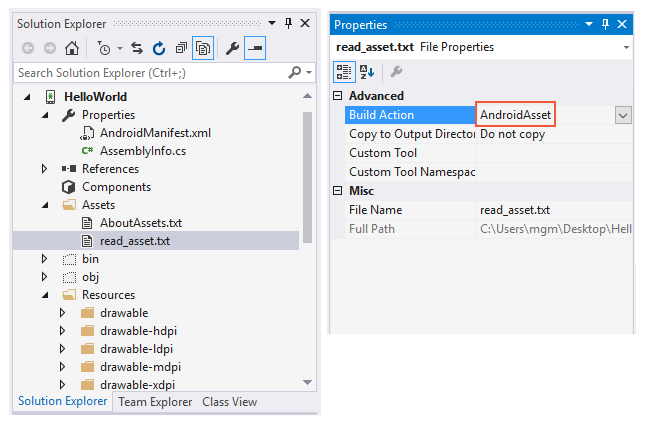資產 可讓您在應用程式中包含任意檔案,例如文字、xml、字型、音樂和視訊。 如果您嘗試將這些檔案包含為「資源」,Android 會將這些檔案處理到其資源系統中,而且您將無法取得原始數據。 如果您想要存取未變更的數據,Assets 是其中一種方式。
新增至專案的資產會顯示為文件系統,而文件系統可以使用 AssetManager 從中讀取。
在這個簡單的示範中,我們將將文本文件資產新增至專案、使用 AssetManager讀取它,並將其顯示在 TextView 中。
將資產新增至專案
資產會移至 Assets 您項目的資料夾中。 將新的文字檔新增至名為 read_asset.txt的這個資料夾。 將一些文字放在它,就像「我來自資產!
Visual Studio 應該已將此檔案的 建置動作 設定為 AndroidAsset:

選取正確的 BuildAction 可確保檔案會在編譯時期封裝到 APK 中。
讀取資產
資產是使用 AssetManager 讀取的。 藉由存取 上的 Android.Content.ContextAssets 屬性,例如 Activity,即可取得 的AssetManager實例。
在下列程式代碼中,我們會開啟 read_asset.txt 資產、讀取內容,並使用 TextView 加以顯示。
protected override void OnCreate (Bundle bundle)
{
base.OnCreate (bundle);
// Create a new TextView and set it as our view
TextView tv = new TextView (this);
// Read the contents of our asset
string content;
AssetManager assets = this.Assets;
using (StreamReader sr = new StreamReader (assets.Open ("read_asset.txt")))
{
content = sr.ReadToEnd ();
}
// Set TextView.Text to our asset content
tv.Text = content;
SetContentView (tv);
}
讀取二進位資產
上述範例中的 用法 StreamReader 非常適合用於文字資產。 針對二進位資產,請使用下列程序代碼:
protected override void OnCreate (Bundle bundle)
{
base.OnCreate (bundle);
// Read the contents of our asset
const int maxReadSize = 256 * 1024;
byte[] content;
AssetManager assets = this.Assets;
using (BinaryReader br = new BinaryReader (assets.Open ("mydatabase.db")))
{
content = br.ReadBytes (maxReadSize);
}
// Do something with it...
}
執行應用程式
執行應用程式,您應該會看到下列內容:

